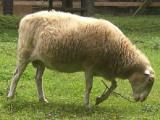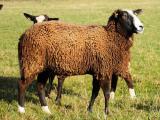
|
White Horned Heath sheepThe White Horned Heath originated from the Grey Horned Heath Sheep and was first developed as a separate breed at the beginning of the 20th century. Originally herds consisted of both horned and polled animals. A few years later they were divided into two breeds, the polled called White Polled Heath or Moorschnucke. |

|
White Mountain sheepThe German Mountain breed is found in the Bavarian Alps and Pre-alps of southern Germany. The breed was developed by grading local breeds to Bergamasca and Tyrol Mountain. It is a coarse to medium wooled breed and is polled. |

|
White Polled Heath sheepThe origin of the hardy and frugal breed is northern German counties of Diepholz, Nienburg, Rotenburg. The White Polled Heath is a white, dual-coated, graceful landrace with a small frame. The slender head has small ears that stick out to the side. Both sexes are hornless and have light-colored, hard hoofs. They mature slowly. |

|
White Suffolk sheepBeginning in 1977, Dr. Ewan Roberts of the University of New South Wales in Australia started a breeding program to develop a terminal sire breed of sheep. His goals were to have a breed with the confirmation, structure, and growth of the Suffolk, but with a white head and legs. The initial cross was between Suffolk and Polled Dorset and separately Suffolk crossed with Border Leicester. The F2 and subsequent generations were selected against black points and for increased gain. |

|
Whiteface Dartmoor sheepThere have been Whitefaced Dartmoors on the Moor since they earliest records. They are also found on parts of Exmoor. The ewes are renowned for crossing to produce a halfbred ewe capable of producing a prime lamb when put to a terminal sire ram. |

|
Whiteface Woodland sheepThe Whitefaced Woodland originated in the South Pennines of England. It is also known as Penistone after the Yorkshire town where sheep sales have been held since 1699. |

|
Wiltipoll sheepThe Wiltipoll is a new breed of sheep, recently developed in Australia from the Wiltshire Horn. It is a polled sheep that is bred for the production of prime lamb only. Its short white fleece is shed annually, from Spring to Summer, where it falls to the ground and is of no commercial value.The absence of horns has been achieved by the infusion of blood from the Border Leicester, Poll Dorset, and Polled Merino breeds. |

|
Wiltshire Horn sheepThe Wiltshire Horn is an ancient British breed from the Chalk Downs region of England. Reaching large numbers during the 17th and 18th centuries, they became almost extinct by the beginning of the 20th. They are currently attracting attention for their lack of wool and the need for shearing, as well as their ability to pass on their vitality and quality meat in a cross-breeding program. |

|
Wrzosówka sheepThe Wrzosówka belongs to the Northern type of short-tailed sheep which have been kept for centuries in different regions of Europe, including Northeastern parts of Poland. It is unique among Polish sheep breeds, since it is extremely adaptable to difficult conditions, disease-resistant, and prolific. It is able to reproduce all year round. |

|
Xinjiang Fine Wool sheepThe Xinjiang Finewool was among the first of the Chinese breeds and it has played a part in the establishment of some other breeds. The original crosses were between Russian Merino rams, probably of the Caucasian, Precoce, and Stravrapol types, with local breeds of ewe. The most important of these breeds was the Kazakh, but some Mongolian ewes were also used. |

|
Zwartbles sheepSince the beginning of the last century, dairy farmers in the Freisland region of Holland have kept Zwartbles Sheep, a strikingly handsome black sheep with a distinctive white blaze and 2 to 4 white "socks." Freisland lies in the North of Holland, and these beautiful and elegant sheep serve as dual purpose animals - meat and milk. Due to changes in farming practices, numbers of Zwartbles in Holland became severely reduced until the breed was adopted by the Dutch Rare Breed Survival trust in the mid-1970s. |
| 1 | 2 | 3 | 4 | 5 | 6 | 7 | 8 |